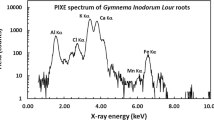Abstract
The use of the Particle Induced X-ray Emission (PIXE) method has enabled the elemental analysis of traditionally used medicinal plants in a specific region of Andhra Pradesh, India. These plants are frequently utilized for treating common ailments like diarrhea, jaundice, asthma, and leprosy. By using the PIXE method, the concentrations of constituent elements, including P, S, Cl, K, Ca, Ti, V, Cr, Mn, Fe, Ni, Cu, Zn, Se, Br, Rb, and Sr, have been determined in selected medicinal plants. These findings provide a possible link to the therapeutic properties of the medicine, as the elemental concentrations have been found to be correlated with the curative capabilities of the plants. This study highlights the potential significance of trace elements in medicinal plants and their implications for treating various diseases.






Similar content being viewed by others
References
Patel NG (1986) India’s traditional medicine: Ayurveda. In: Steiner RP (ed) Folk medicine: the art and science. American Chemical Society, Washington D.C., p 41
Lokhande R, Singare P, Andhele M, Acharya R (2010) Nat Sci 2:26–32
NomitaDevi K, NandakumarSarma H, Kumar S (2008) Nucl Instrum Methods B 266:1605
Ekinci N, Ekinci R, Polat R, Budak G (2004) J Radioanal Nucl Chem 260:127–131
Balaji T, Acharya RN, Nair AGC, Reddy AVR, Rao KS, Naidu GRK, Manohar SB (2000) J Radioanal Nucl Chem 243:783–788
Johansson TB, Aksellsson R, Johansson SAE (1970) Nucl Instr Meth B 84:141–143
Govil IM (2001) Curr Sci 80:25
Johnson M, Wesely EG, ZahirHussain MI, Selvan N (2010) Asian Pacific J Trop Med 3(11):894–897
Shailajan S, Yeragi M, Tiwari B (2013) Int J Green Pharm 7(1):62–65
Anu KK, Sornaraj R (2011) Int J Pharm Tech Res 3(4):2025
Arun Raj GR, Shailaja U, Prasanna NR, Ajayan S (2013) J Ayurveda Holistic Med 1(1):22–36
Dipali S, Sucheta T, Tejaswini K (2014) J Curr Phar Res 4(3):1194–1200
Namrata GM, Manojkumar ZC, Raghunath TM (2015) Int J Pharm Res Allied Sci 4(3):48–74
Maxwell JA, Campbell JL, Teesdale WJ (1989) Nucl-Instrum Meth B 43:218
Maxwell JA, Campbell JL, Teesdale WJ (1995) Nucl-Instrum Meth B 95:407
Br Med J (1977) 1(6059): 469–470
Feinendegen LE, Kasperek K (1980) in Braetter TP, Schramel P (Eds.), de Gruyter, Berlin, p 1
Vuokho L, Kinnula James D (2003) Craps Am J Respir Crit Care Med 167:1600
Lukac N, Massanji P (2003) J Epidemiol Microbial Immunol 56(1):3
Khan SA, Khan L, Hussain I, Marwat KB, Ashtray N (2008) Pak J Weed Sci Res 14:101
Lee N, Yoo H, Yang H (2021) Cluster analysis of medicinal plants and targets based on multi particle network. Biomolecules 11(4):546
Acknowledgements
The authors express their gratitude to the authorities and team at the Institute of Physics, Bhubaneswar for providing access to the pelletron accelerator facility. The authors would also like to acknowledge Dr. Anup Kumar Behera and Dr. Dinesh Roy from IOP, Bhubaneswar for their unwavering support and assistance. Additionally, this study was presented at the NAT2022, the International Conference on Nuclear Analytical Techniques, which took place in Daejeon, Korea from December 7th to 9th, 2022. The authors have no conflicts of interest to declare.
Author information
Authors and Affiliations
Corresponding author
Additional information
Publisher's Note
Springer Nature remains neutral with regard to jurisdictional claims in published maps and institutional affiliations.
Rights and permissions
Springer Nature or its licensor (e.g. a society or other partner) holds exclusive rights to this article under a publishing agreement with the author(s) or other rightsholder(s); author self-archiving of the accepted manuscript version of this article is solely governed by the terms of such publishing agreement and applicable law.
About this article
Cite this article
Ratnaraju, M., Rao, P.V.M., Dasari, K.B. et al. Determination of trace, minor and major elements of medicinal plants used for common diseases through PIXE method. J Radioanal Nucl Chem 332, 5247–5252 (2023). https://doi.org/10.1007/s10967-023-09074-1
Received:
Accepted:
Published:
Issue Date:
DOI: https://doi.org/10.1007/s10967-023-09074-1




